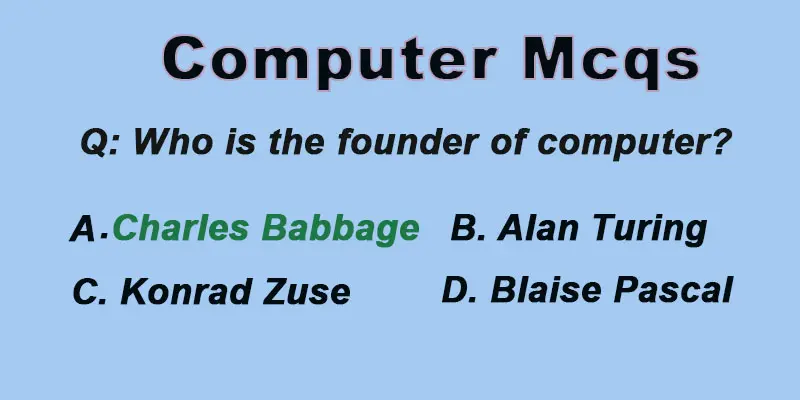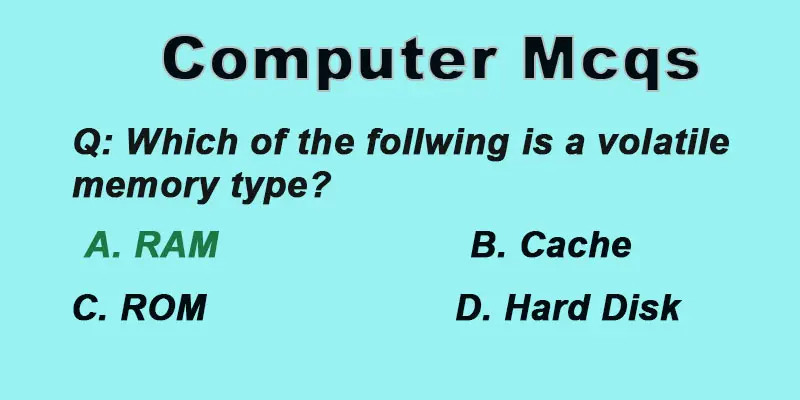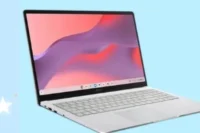Mcqs Computer Fundamentals – 80 Multiple Choice Questions Computer
Published: 4 Feb 2024
About Computer Fundamentals
Multiple-choice questions (MCQs) about computer basics are important for learning how computers function. Understanding these basics is important in today’s digital world. It covers simple things like parts of computers (hardware and software) to more advanced topics like coding and networks. Whether you’re new to computers or refreshing your knowledge, mastering these basics is the first step to becoming skilled with computers.
Let’s Start and Practice Computer Fundamentals Mcq
Multiple-choice questions (MCQs) on computer fundamentals help test and improve our understanding of basic computer concepts, like hardware, software, and how computers work.

What does SSD stand for in computer hardware?
- Super Speed Drive
- Solid State Drive
- Serial Storage Device
- System Storage Drive
Answer: 2
What is the purpose of a DNS server?
- To translate domain names to IP addresses
- To host websites
- To store email messages
- None of the above
Answer: 1
What is the purpose of a motherboard in a computer system?
- Provide a platform for computer components
- To regulate voltage and current
- To control system resources
- None of the above
Answer: 1
What is the purpose of a power supply unit in a computer system?
- To provide power to components
- To connect the computer to a network
- To process data
- None of the above
Answer: 1
What is the purpose of a power supply unit in a computer system?
- To provide power to components
- To connect the computer to a network
- To process data
- None of the above
Answer: 1
What is the purpose of a cooling system in a computer system?
- To regulate temperature
- To connect the computer to a network
- To store data
- None of the above
Answer: 1
Which data type represents true or false values in programming languages?
- String
- Boolean
- Integer
- Float
Answer: 2
What is the purpose of a data backup?
- Encrypting data
- Preventing unauthorized access
- Creating duplicates of data for recovery in case of loss
- Sorting data alphabetically
Answer: 3
What does the term “Big Data” refer to?
- Extremely large and complex datasets
- Small-sized datasets
- Encrypted data
- Real-time data processing
Answer: 1
What is meant by CAT5e in the context of network cables?
- Category 5e
- Cable Assembly Twisted Pair 5th edition
- Computer Access Twisted 5 enhanced
- None of the above
Answer: 1
Which component coordinates data transfer between the CPU and other devices, such as hard drives and graphics cards?
- Northbridge
- Southbridge
- FPU (Floating Point Unit)
- ALU (Arithmetic Logic Unit)
Answer: 2
What is the purpose of the CPU’s register?
- To store frequently used program instructions
- To manage input and output devices
- To perform arithmetic operations
- To control the clock speed
Answer: 1
Which technology allows a CPU to halt its operation and save power temporarily?
- Overclocking
- Power gating
- Pipelining
- Hyper-Threading
Answer: 2
The CPU’s L1 cache is typically:
- Larger than the L2 cache
- Smaller than the L2 cache
- The same size as the L2 cache
- Not present in modern CPUs
Answer: 2
Which component connects the CPU to the system memory and other peripherals on the motherboard?
- Northbridge
- Southbridge
- GPU (Graphics Processing Unit)
- RAM (Random Access Memory)
Answer: 1
The CPU’s L2 cache is typically:
- On the same chip as the CPU
- Off-chip, but on the same die as the CPU
- On a separate chip from the CPU
- Not present in modern CPUs
Answer: 3
Which CPU feature allows it to execute multiple instructions in parallel by dividing them into smaller stages?
- Hyper-Threading
- Out-of-order execution
- Pipeline processing
- Clock multiplier
Answer: 3
The process of fetching and executing multiple instructions simultaneously is known as:
- Multi-threading
- Multi-tasking
- Parallel processing
- Overclocking
Answer: 3
What is the difference between data and information?
- Data is processed information
- Information is processed data
- Data and information are synonymous
- Data and information refer to different units of measurement
Answer: 2
The CPU socket on a motherboard is designed to:
- Store data permanently
- Connect to external devices
- Hold the CPU in place
- Manage input and output operations
Answer: 3
What is the function of the CPU’s FPU (Floating Point Unit)?
- To handle floating-point arithmetic operations
- To manage file storage
- To control input devices
- To interpret program instructions
Answer: 1
In a database, what is a foreign key?
- A key used for opening doors
- A key used for encryption
- A field that refers to the primary key in another table
- A key used for network connections
Answer: 3
What is data warehousing?
- Storing data in a secure vault
- A centralized repository for storing and managing large volumes of data from different sources
- Encrypting data for transmission
- Running applications
Answer: 2
What is the role of the CPU’s I/O controller?
- To perform arithmetic operations
- To manage input and output operations
- Interpret program instructions
- To store frequently used data
Answer: 2
Which CPU feature allows it to execute multiple instructions simultaneously?
- Hyper-Threading
- Clock multiplier
- Cache memory
- Pipeline processing
Answer: 1
What is the purpose of a data dictionary?
- Storing encrypted data
- Managing network connections
- Describing the structure and characteristics of data
- Creating graphical designs
Answer: 3
The CPU is often referred to as the “brain” of the computer because:
- It controls the computer’s memory
- It performs arithmetic and logical operations
- It manages input and output devices
- It stores data permanently
Answer: 2
What is the purpose of the CPU cache?
- To store frequently used program instructions and data
- To provide additional processing power
- To manage input and output operations
- To store the operating system files
Answer: 1
Which unit is used to measure the clock speed of the CPU?
- Megabytes
- Gigahertz
- Kilobytes
- Terabytes
Answer: 2
The ALU (Arithmetic Logic Unit) of a CPU is responsible for:
- Managing memory
- Performing mathematical and logical operations
- Controlling input devices
- Storing data permanently
Answer: 2
Which data type is used to store whole numbers in programming languages?
- Float
- String
- Integer
- Boolean
Answer: 3
What is the control unit of the CPU used for?
- To perform arithmetic operations
- To fetch and interpret program instructions
- To store data permanently
- To manage input and output devices
Answer: 2
What is the purpose of a descreening filter in scanners?
- Removing unwanted colors from scans
- Reducing moiré patterns when scanning printed material
- Enhancing the contrast of scanned images
- Adjusting the focus during scanning
Answer: 2
Which scanning technology involves capturing images by reflecting light off a rotating drum?
- Drum scanning
- Laser scanning
- CIS scanning
- 3D scanning
Answer: 1
The term “ADF capacity” in scanner specifications refers to:
- The maximum scanning resolution
- The speed of document feeding
- The number of pages the Automatic Document Feeder can hold
- The size of the scanning area
Answer: 3
Which scanning technology uses lasers to capture images of 3D objects accurately?
- Drum scanning
- Laser scanning
- CIS scanning
- Film Scanning
Answer: 2
What is the purpose of OCR software in conjunction with a scanner?
- To calibrate the scanner for optimal performance
- To recognize and convert text from scanned images into editable text
- To adjust the color balance of scanned photos
- To automatically crop scanned documents
Answer: 2
Which scanning technology captures images by passing light through an object onto a sensor?
- Drum scanning
- Laser scanning
- Transmission scanning
- CIS scanning
Answer: 3
What is the purpose of despeckle in scanning software?
- Removing dust and scratches from scanned images
- Enhancing the resolution of scanned documents
- Reducing speckles or noise in scanned images
- Adjusting the brightness and contrast of scanned photos
Answer: 3
The term “ADF” in scanner features stands for:
- Advanced Document Formatting
- Automated Data Filing
- Automatic Document Feeder
- Adjustable Density Function
Answer: 3
Which scanning technology involves capturing images by bouncing light off the surface of an object?
- Drum scanning
- Laser scanning
- 3D scanning
- CIS scanning
Answer: 3
The term “RGB” in scanner specifications stands for:
- Red, Green, Blue
- Regular, Glossy, Black
- Reflection, Grayscale, Brightness
- Rotational, Gamma, Blur
Answer: 1
What is the purpose of a TWAIN driver in scanning?
- To enhance color accuracy
- To facilitate communication between scanners and software applications
- To control the scanning speed
- To improve the scanning resolution
Answer: 2
Which type of scanner is suitable for capturing detailed images and textures of 3D objects?
- Drum scanner
- Flatbed scanner
- Handheld scanner
- 3D scanner
Answer: 4
The term “dpi” in scanner specifications stands for:
- Dots Per Inch
- Digital Photo Imaging
- Document Printing Interface
- Dynamic Processing Integration
Answer: 1
Which scanning feature allows users to preview the scanned image before saving it?
- Auto-crop
- Preview mode
- Resolution adjustment
- Image enhancement
Answer: 2
Which technology is commonly used in flatbed scanners to capture images?
- Laser scanning
- CCD (Charge-Coupled Device)
- OCR (Optical Character Recognition)
- Magnetic scanning
Answer: 2
The term “resolution” in scanner specifications refers to:
- Printing speed
- Color accuracy
- The sharpness and detail of scanned images
- Connectivity options
Answer: 3
Which type of scanner uses light-sensitive cells to capture images and is often found in handheld scanners?
- Drum scanner
- Flatbed scanner
- CIS (Contact Image Sensor) scanner
- Sheet-fed scanner
Answer: 3

The process of converting a physical document into an electronic format is:
- Scanning
- Printing
- Copying
- Faxing
Answer: 1
What is a sheet-fed scanner’s main benefit over a flatbed scanner?
- Higher resolution
- Faster scanning of multiple documents
- Better color reproduction
- Greater depth of field
Answer: 2
OCR (Optical Character Recognition) technology in scanners is used for:
- Scanning barcodes
- Recognizing and converting text into editable content
- Capturing 3D images
- Scanning fingerprints
Answer: 2
Which type of scanner is commonly used for scanning film negatives and slides?
- Drum scanner
- Flatbed scanner
- Film scanner
- Sheet-fed scanner
Answer: 3
The term “dpi” in printer specifications stands for:
- Dots Per Inch
- Digital Photo Imaging
- Document Printing Interface
- Dynamic Printing Innovation
Answer: 1
What is the purpose of a thermal printer?
- Creating three-dimensional objects
- Printing by striking pins against an ink ribbon
- Using heat to transfer color dye onto paper
- Producing high-resolution photo prints
Answer: 3
Which printer feature allows multiple pages to be automatically fed and scanned for copying or printing?
- Duplex printing
- Collate
- Automatic Document Feeder (ADF)
- Wireless printing
Answer: 3
The term “RGB” in printer specifications stands for:
- Red, Green, Blue
- Regular, Glossy, Bold
- Refillable, Gray, Black
- Rapid, Gradient, Bright
Answer: 1
What is the purpose of data normalization in databases?
- Reducing redundancy and improving data integrity
- Encrypting sensitive information
- Increasing data duplication
- Enhancing data visualization
Answer: 1
The term “watermark” in printer settings refers to:
- A security feature on banknotes
- A visible logo or text on printed pages
- An ink-absorbing material in print heads
- A type of printing paper
Answer: 2
What is the purpose of a fuser unit in a laser printer?
- Applying toner to the paper
- Transferring images onto the paper
- Fusing toner onto the paper using heat
- Cleaning the print heads
Answer: 3
In computing, what does the acronym CRUD stand for?
- Computer Resource Utilization and Distribution
- Create, Read, Update, Delete
- Centralized Routing and User Design
- Cryptographic Randomization and Utility Deployment
Answer: 2
What is the primary function of a computer scanner?
- Producing hard copies of digital content
- Entering data into a computer
- Displaying information on a screen
- Storing files permanently
Answer: 2
Why would someone use a 3D printer?
- Producing high-quality photo prints
- Creating three-dimensional physical objects layer by layer
- Printing on both sides of the paper
- Using thermal wax for printing
Answer: 2
The “cartridge” in an inkjet printer typically contains:
- Toner
- Liquid ink
- Powdered ink
- Solid ink sticks
Answer: 2
What is the primary advantage of a laser printer over an inkjet printer?
- Lower initial cost
- Faster printing speed
- Better color accuracy
- Higher resolution
Answer: 2
The term “CMYK” in printer specifications stands for:
- Cyan, Magenta, Yellow, and Key
- Color, Monochrome, Yellow, and Black
- Compression, Magnification, Yield, and Kinetics
- Coated, Matte, Yellow, and Kindle
Answer: 1
What is data?
- Information in digital form
- Physical computer components
- Software programs
- Electrical signals
Answer: 1
What is the primary function of a computer printer?
- Entering data into a computer
- Displaying information on a screen
- Producing a hard copy of digital content
- Storing files permanently
Answer: 3
The term “resolution” in printer specifications refers to:
- Printing speed
- Color accuracy
- Print quality and sharpness
- Connectivity options
Answer: 3
What is the purpose of a dot matrix printer?
- Producing high-resolution photo prints
- Creating three-dimensional objects
- Printing by striking pins against an ink ribbon
- Using laser technology for printing
Answer: 3
Which of the following is a function of the job scheduler in an operating system?
- Allocating memory
- Managing network connections
- Selecting processes from the job pool to be executed
- Providing internet security
Answer: 3
What is the purpose of a semaphore in operating systems?
- Managing files and folders
- Controlling access to shared resources and preventing race conditions
- Providing internet security
- Allocating memory
Answer: 2
The “toner” in a laser printer consists of:
- Liquid ink
- Powdered ink
- Thermal wax
- Solid ink sticks
Answer: 2
What is the role of the memory manager in an operating system?
- Managing network connections
- Allocating and deallocating memory space for processes
- Running applications
- Providing internet security
Answer: 2
Which component is responsible for rendering images and videos on a computer screen?
- CPU
- RAM
- Graphics Processing Unit (GPU)
- Hard Disk Drive (HDD)
Answer: 3

What does the acronym USB stand for in the context of computer hardware?
- Universal Serial Bus
- Uninterruptible Power Supply
- Ultrafast Storage Block
- Unified System Backup
Answer: 1
What is the purpose of a 3D printer?
- Producing high-quality photo prints
- Creating three-dimensional physical objects layer by layer
- Printing on both sides of the paper
- Using thermal wax for printing
Answer: 2
The “cartridge” in an inkjet printer typically contains:
- Toner
- Liquid ink
- Powdered ink
- Solid ink sticks
Answer: 2
What is the primary advantage of a laser printer over an inkjet printer?
- Lower initial cost
- Faster printing speed
- Better color accuracy
- Higher resolution
Answer: 2
The term “CMYK” in printer specifications stands for:
- Cyan, Magenta, Yellow, and Key
- Color, Monochrome, Yellow, and Black
- Compression, Magnification, Yield, and Kinetics
- Coated, Matte, Yellow, and Kindle
Answer: 1
Conclusion about Computer Fundamentals mcq
Multiple-choice questions (MCQs) about computer basics are essential for learning about the technology that’s so important in our daily lives. Understanding these fundamentals is important, whether fixing computer problems, learning basic computer concepts, writing code, or keeping networks safe. As technology progresses, having a solid grasp of computer basics will continue to be important for succeeding in a world that relies heavily on digital technology.

- Be Respectful
- Stay Relevant
- Stay Positive
- True Feedback
- Encourage Discussion
- Avoid Spamming
- No Fake News
- Don't Copy-Paste
- No Personal Attacks

- Be Respectful
- Stay Relevant
- Stay Positive
- True Feedback
- Encourage Discussion
- Avoid Spamming
- No Fake News
- Don't Copy-Paste
- No Personal Attacks





